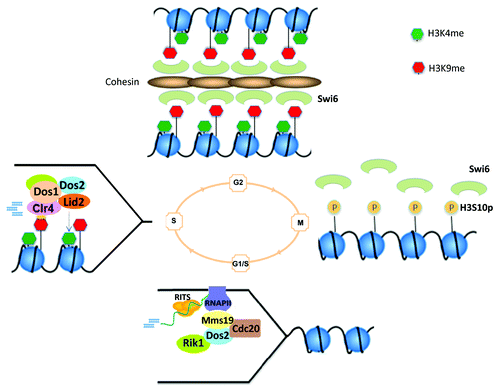Figures & data
Figure 1. Co-regulation of DNA replication and RNAi-dependent heterochromatin assembly: Model for inheritance of H3K9me. 1) At G1/S phase, the DNA polymerase ε subunit, Cdc20, in addition to its role in leading strand synthesis at replication forks, recruits Dos2 and Rik1. It also recruits the transcriptional regulator Mms19, which in turn recruits RNAP II to initiate heterochromatin transcription. Nascent heterochromatin transcripts are then processed into siRNAs via RNAi activity; 2) At S phase, newly made siRNAs, in concert with Dos1, Dos2 and Rik1, mediate H3K9 methylation and H3K4 hypomethylation through their interaction with the histone methylation enzymes, Clr4 and Lid2; 3) At G2, newly deposited H3K9 methylation marks serve as a docking sites for Swi6 binding, which promote the restoration of condensed heterochromatic structures; 4) at M phase, H3S10 phosphorylation levels begin to increase steadily into early S phase leading to decreased H3K9 methylation and Swi6 binding required for the initiation of a new cycle of heterochromatin transcription and re-assembly in the next generation.
